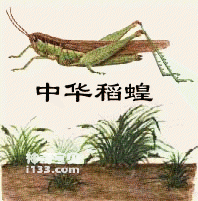Locusts cause serious damage to crops. In old China, people compared locusts with floods and droughts and called them "locust plagues." The most powerful kind of locust is called migratory locust, which often migrates in groups over long distances. It flies very fast and can fly continuously for dozens of hours. It can fly hundreds of miles at a time and reach an altitude of up to 2,000 miles. meters and above. Locusts were like dark clouds in the sky, covering the sky in a large black mass. As soon as it landed, it was like a machine gun, boom! Crack! Crack! In the blink of an eye, the green crops were eaten up. In the past two thousand years of our country's history, there have been more than 800 major locust plagues recorded, displacing six to seven million farmers and fleeing from famine. When severe locust plagues occur, they can lead to wars. In 1942, locusts in Huanghua County, Hebei Province not only ate all the crops and reeds, but also the paper taped to the windows. A swarm of migratory locusts rushed into the farmer's house and bit the child's ears. In Chinese history books, phrases such as "the red ground is thousands of miles away and not a blade of grass is left behind" are often used to describe locust plagues. Farmers have such a song to denounce the locust plague! "Locusts, locusts, like a fierce dragon. Once the fierce dragon passes by, nine out of ten families will be poor." You can imagine the severity of the locust plague. A large locust swarm can eat 160,000 tons of food every day, and the same amount of food can feed 800,000 people for a year.

According to reports, a severe locust plague occurred in the Horn of Africa in early 1978. At first, more than fifty locust swarms appeared in the desert areas of Saudi Arabia. These hungry locust swarms followed the monsoon and crossed the Red Sea into Ethiopia and Somalia. In addition, another twenty-six locust swarms crossed the Indian Ocean and flew to India and Iran. and Pakistan. Another kind of locust is called the desert locust, which is a regular scourge in Africa and Asia. Wherever it goes, it wipes out all kinds of green plants. One square mile of locusts can eat fourteen tons of food per day, and each locust eats twice its own weight in food per day. Africa was invaded four times by desert locusts in 1957 and 1968. In 1946, a swarm of migratory locusts descended on Morocco, covering an area of dozens of square kilometers and leaving no green anywhere. Computer calculations show that the swarm of locusts weighs about 500,000 tons and would require 1,000 train skins to contain them. The largest locust flight in the world was when a group of desert locusts flew over the Red Sea in 1889. The area spread reached square kilometers, equivalent to 86% of the entire Shanghai area. It is estimated that there are about 250 billion locusts, with a total weight of 508,000 tons. In East Africa, someone observed a swarm of locusts advancing in a formation 30 meters high and 500 meters wide. It took 9 hours for them to pass through. In 1779, locusts in South Africa affected an area of 3,200 square kilometers. The dead locusts blown down by strong winds were 1 meter high and 80 kilometers long. In 1972, a locust plague occurred in Shandong, my country, displacing 7 million people and fleeing for famine. With the help of wind, locusts can fly 80 kilometers a day. They fly thousands of kilometers before stopping to reproduce.
In order to find out the flying ability of locusts, Australia invented a radar. It can detect the gathering of large swarms of locusts within 50 kilometers to 80 kilometers at night, and detect the possible invasion of a certain place by the locust swarm based on weather changes, so that timely measures can be taken. A locust swarm often contains tens to dozens of tons of locusts.
In order to deal with this pest, East African countries are cooperating closely with each other, establishing organizations, holding meetings, taking various measures, providing pest control tools and pesticides to the affected countries, and taking joint actions to monitor locust movements. These measures have played a certain role in controlling and eliminating locust plagues.
animal tags:
We created this article in conjunction with AI technology, then made sure it was fact-checked and edited by a Animals Top editor.